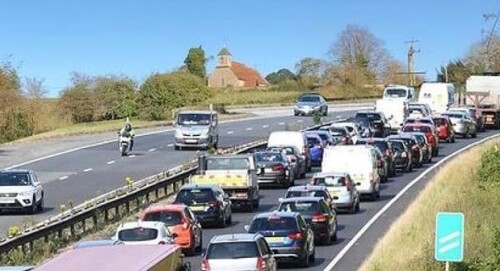National Highways' failed consultations
Time after time the consultations on the Arundel Bypass were mishandled, misdirected, full of mistruths and concealments, seeking to limit, channel and ultimately disregard responses. National Highways are still refusing to reveal how many people that responded to the last consultation, did not want it to go ahead. The Secretary of State of the last government ended up kicking this shamefully mishandled National Highways project forward to RIS3 2025-2030, and told National Highways to pay more attention to the environment and to communities.
National Highways are said to have misspent about £20M on their Arundel Bypass failures to date. Their response to the Secretary of State's 9.3.23 decision was to announce a prospect of more consultations to 'fine tune' the scheme. No, National Highways: listen to the previous consultations' responses first, and then come up with something new, and far less costly to the environment, to communities and to the public purse. Thankfully, new Chancellor Rachel Reeves seems to be of a like mind with ourselves on that. There are plenty of lessons National Highways should learn from all those failed consultations.
The October - December 2022 Supplementary Consultation
It is clear that this was as abject a failure as the 2019 consultation and the spring 2022 Statutory Consultation. Environmental concerns were not adequately addressed. Nor were the concerns of communities. National Highways wanted to be able to say to the Planning Inspectorate, "look, we made these changes and now far fewer people are objecting". Perhaps they hoped the public would have 'consultation fatigue'. National Highways are so embarrassed by the number of continued objections to the scheme as such that they have refused to reveal an analysis of the numbers objecting.What was wrong with the autumn 2022 design changes:
National Highways claim they are reducing traffic through the villages - that is not true. Their figures say that the increase in off-A27 traffic through The Street in Walberton, which their Grey route will cause, will not be so huge after all. But they are actually just moving it to a different part of Walberton, past the village greens where children play. And of course the scheme itself doesn't just create new rat-runs through the villages, it drives a new 8km dual carriageway through previously tranquil villages and countryside. They claim they have provided a bat crossing - but this will not stop the killing of the 16 species of bats regularly criss-crossing the whole 8km length of the route. These few small changes make very little difference to the devastating impacts of this destructive new road proposal.
What's still wrong with the Arundel Bypass Grey route
This devastating new road still:
- cuts through two villages and ruins another
- is likely to cost up to a billion pounds which is badly needed elsewhere
- spoils the beauty and tranquillity of the watermeadows south of Arundel and the Binsted Rife valley
- has serious climate change impacts in construction and use
- cuts through a huge, fantastic wildlife haven of 'exceptionally rich biodiversity' (Natural England)
- fails to consider the Arundel Alternative which is an appropriate 21st century solutionSo, it's essential we all write in again to express our opposition. It can be as simple as emailing A27ArundelBypass@nationalhighways.co.uk , subject 'consultation', with your objection.
Say you object to their whole scheme, including the inadequacy of thesenot just to the latest changes. Give your name and address or at least your postcode. It is much more powerful if you can give a number of reasons, in your own words. You can also fill in their online form here, making sure to say in the final comments box that you object to the whole scheme.
THANK YOU! For more info, click on the grey "+" tabs below to open a section, and click again to close.
-
Who can take part?
-
Anyone can respond to the consultation.
- You can send more than one response
- If you have already responded and now have more to say then please respond again!
- You don't have to live locally to the Arundel and Walberton area, anyone from anywhere can take part if they wish
- It is not limited to one per household, everyone can take part
- Children can take part with parent/guardians permission. If they prefer to draw their response an adult can give a brief interpretation if needs be to help National Highways' analysis
- Businesses, school, forums, clubs, organisations etc can also take part, not just individuals
- As long as you have permission to make an official representation on behalf of the company/organisation you can submit a response on their behalf. This doesn’t stop you also taking part as an individual too.
-
-
Why is it important to use your own words?
-
Where template letters have been used, National Highways has lumped thousands of individuals' responses together and treated them as worth no more than a single response. So, please do not just copy and paste paragraphs word for word from our website or social media posts - please make your comments in your own words!
National Highways also treat online petition responses the same way. For consultation analysis purposes, they treat the whole petition as a single response. So if you are one of the more than 6000 people who have signed our petition, it is really important to make your individual consultation response too. (Petition responses are valuable for a different purpose, influencing politicians and initiating local authority debates, so please keep sharing our Petition, using this link.)
Every individual response counts, so please make sure they rate yours as individual. Your own wording will make it personal to you.
-
-
How to take part
-
How to take part
The information National Highways wants to present to you, to persuade you to support this damaging development, with dates for local exhibitions, some of them staffed by National Highways' staff and consultants, can be found on their Arundel webpage https://nationalhighways.co.uk/our-roads/south-east/a27-arundel-bypass/ , or you can download this info here.
If you respond using the National Highways (NH) consultation response form, you will find that NH have designed the form to discourage most people from saying what they really think about the bypass proposals, and just to get the limited feedback NH wants. The comment panel on the form can be used however you like - but it is small. So:
Our recommended way to respond is to send your own comments in your own words either via email or post:
-
EMAIL – Send your comments to: A27ArundelBypass@nationalhighways.co.uk . If you can only respond one way, this is the best way to do it. In your email, please give your reasons for objecting - as long or as short as you like - the longer the better! You should put 'consultation' in the subject line, and sign off witih your Name, Address and Postcode.
-
POST – Send your comments to FREEPOST A27 ARUNDEL (capitals are required)
The freepost address is the only text needed on the envelope and no stamp is required.
Remember to give your Name, Address and Postcode.
If you wish to ALSO respond on the official Feedback Form, you can use the paper form, or you can complete it online on the scheme website www.nationalhighways.co.uk/a27arundel . You can use the last, 'Further Comments' panel to say why you object to the scheme.
We have until 23:59 on 16th December 2022 to respond to the consultation. Please do use the official channels above to respond, to ensure that National Highways have to include your response in their analysis.
After this Consultation, , in spring 2023, National Highways want to take their proposals to the Planning Inspectorate with a Development Consent Order (DCO) application; info about this process is presented here. They will have to present the results of their 2022 consultations with their DCO application: let's make sure this second 2022 consultation gives as resounding a "NO!" as the first.
-
-
-
Who can take part?
If you would like support us, then send us an email with your contact details.
We will keep you in touch with Arundel A27 affairs by e-newsletter.

